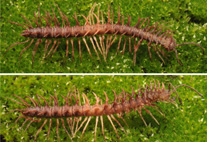Abstract
We identified a new species, Nanocladius (Plecopteracoluthus) shigaensis, from Shiga and Gifu Prefectures, Japan, whose larvae are phoretic on nymphs of Plecoptera. Although this new species is morphologically similar to Nanocladius (Plecopteracoluthus) asiaticus Hayashi (1998), which is phoretic on Megaloptera larvae, it differs from N. (P.) asiaticus: the color of the larval head capsule is light brown in N. (P.) shigaensis and dark brown in N. (P.) asiaticus and the larval capsule index of the former is significantly larger than that of the latter. Moreover, analyses based on DNA sequence of cytochrome c oxidase subunit I (COI) supported the hypothesis that N. (P.) shigaensis and N. (P.) asiaticus are two distinct species. This is the first record of a phoretic chironomid on a plecopteran nymph in the Palaearctic region.

